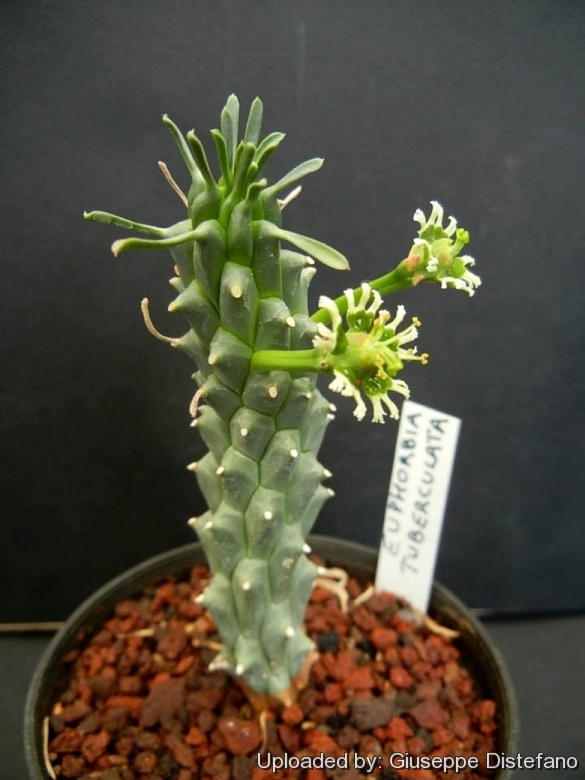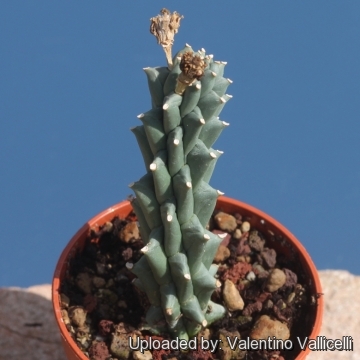Accepted Scientific Name: Euphorbia tuberculata Jacq.
Pl. Hort. Schoenbr. 2: 43 1797 Jacq.

Medusea tuberculata (Euphorbia tuberculata) Photo by: Giuseppe Distefano
Origin and Habitat: It is widely distributed in the western Cape and Northern Cape, Malmesbury north to Namaqualand.
Habitat: It grows in sand flats in very dry open areas amongst stands of volstruisgras (Cladoraphis spinosa) and scattered succulent and spiny plants.
Synonyms:
See all synonyms of Euphorbia tuberculata
back
Accepted name in llifle Database:Euphorbia tuberculata Jacq.Pl. Hort. Schoenbr. 2: 43 1797Synonymy: 6
back
Common Names include:
AFRIKAANS (Afrikaans): Noordpol
Description: Euphorbia tuberculataSN|25197]]SN|25197]] is a medusoid looking succulent Euphorbia with an almost completely buried primary shoot with radiating tubercled branches. It slowly forms a rounded low-growing spineless rosette up to 60 cm tall and up to 75 cm wide.
Rootstock (caudex): The fleshy root, merges into the underground primary stem to form a stout obconic caudex producing many branches radiating from a central tuberculate growing point. It is a specialized organ for water storage and grows wholly or partly buried in the ground.
Branches: Numerous, tubercled, unbranched, cylindric or slightly thickened upwards, up to 50 cm long and up to 4 cm in diameter, green or grey-green, upright or lying on the ground, often facing toward the North – hence the common Afrikaans name Noordpol (Northern-pole).
Tubercles: Rhomboid to conical 6-8 mm long, 2-6 mm broad and 2-7 mm prominent and glabrous.
Leaves: Insignificant on tips of branches. 1-2,5 cm long, 2-4 mm wide.
Spines: Spineless, but the branches beset with the hardened persistent remains of the peduncles, not true spines, linear, channelled down the face from incurved margins, acute, soon deciduous, glabrous, somewhat fleshy.
Flowers: Quite spectacular for an Euphorbia, in the axils of the tubercles at the tips of the branches, large, white and sort-of Daisy-like on a solitary peduncle approx. 1-2 cm long. The peduncle hardens and persists. Cyathia (involucres) subtended by about 4 bracts and 1 cyathium at the apex, glabrous; bracts 3-4 mm long and 2-4 mm broad, elliptic or elliptic-obovate, obtuse, concave, glabrous, ciliate; cyathium (involucre) 10-14 mm in diameter, broadly bowl-shaped, glabrous outside and within, with 5 nectar glands and 5 subquadrate toothed or nearly entire and minutely ciliate lobes; nectar glands closely sessile on the cup of the involucre, 3-5 mm long, 3-6 mm broad at the tips, broadly cuneately palmatifid, divided to half-way down into 3–6 linear spreading processes, recurved at the tips, slightly dilated or once or twice shortly bifid at the apex, glabrous, green and not pitted on the undivided or glandular part and the processes white: ovary sessile, quite included in the involucre, thickly pubescent with erect stiffish or somewhat bristle-like hairs; styles exserted, 5-6 mm long, united nearly to the apex, with very short slightly spreading thickened or bifid tips; The glands are light-green and end in cream coloured processes.
Fruit: Capsules.
Subspecies, varieties, forms and cultivars of plants belonging to the Euphorbia caput-medusae group
Bibliography: Major references and further lectures
1) Urs Eggli “Illustrated Handbook of Succulent Plants: Dicotyledons” Volume 2. Springer, 2002
2) Werner Rauh “The Wonderful World of Succulents: Cultivation and Description of Selected Succulent Plants Other Than Cacti” Smithsonian Institution Press, 1984
3) Ernst Van Jaarsveld, Ben-Erik Van Wyk, Gideon Smith “Succulents of South Africa: a guide to the regional diversity” Tafelberg, 01/July/2000
4) N. E. Brown, J. Hutchinson and D. Prain “Flora Capensis” Vol 5 Part 2, page 216 (1925)
5) K. L. Willdenow “Species Plantarum.” Editio Quarta. Berolini [Berlin]
6) von Staden, L. & Helme, N.A. 2008. Aloe plicatilis (L.) Mill. National Assessment: "Red List of South African Plants" version 2013.1. Accessed on 2014/03/30
 Medusea tuberculata (Euphorbia tuberculata) Photo by: Valentino Vallicelli
Medusea tuberculata (Euphorbia tuberculata) Photo by: Valentino VallicelliSend a photo of this plant.The gallery now contains thousands of pictures, however it is possible to do even more. We are, of course, seeking photos of species not yet shown in the gallery but not only that, we are also looking for better pictures than those already present.
Read More... Cultivation and Propagation: Euphorbia tuberculataSN|25197]]SN|25197]] is an easy species to grow that is suited for any well drained soil in full sun. It is cultivated as an ornamental, and is a particular favourite of succulent plant enthusiasts.
Growing rate: It is a relatively slow growing and long lived plant and once established, it will be content in its position and with its soil for years.
Soil and pots: It likes deep pot with generous drain holes to accommodate its tap root, needs a very airy potting medium very permeable to water which mainly consists of non organic material such us clay, pumice, lava grit, expanded slate and only a little peat or leaf-mould. Re-pot every two years.
Fertilization: Need a perfect fertilizer diet in summer. Use preferably a cacti and succulents fertilizer with high potassium content including all micro nutrients and trace elements or slow release fertilizer.
Exposure: It can tolerate moderate shade, and a plant that has been growing in shade should be slowly hardened off before placing it in full sun as the plant will be severely scorched if moved too suddenly from shade into sun.
Watering: Water regularly during the active growing season. No water should ever be allowed to stand around the roots. Keep almost completely dry in winter. However this spurge will tolerate dryness and can even thrives in poor, dry soils, but do better when grown in nutrient-rich soils with regular watering.
Hardiness: Some cold tolerance. This spurge has tolerated temperatures down to –6ºC and even a little snow. However it can be difficult to get it to look its best without a good amount of heat and sun (USDA Zones 8-11)
Rot: Rot it is only a minor problem with Euphorbias if the plants are watered and “aired” correctly. If they are not, fungicides won't help all that much.
Known hazards: As with all other Euphorbias when a plant get damaged it exudes a thick white milky sap known as latex. This latex is poisonous, and may irritate skin. Pay extreme attention not to get any in your eyes or mouth. Cultivated plants must be handled carefully.
Propagation: The plant can be reproduced by seeds or cuttings If you take a cutting from this plant, you will get a strange bunch of sideways 'fingers' that will not come true to the shape of the parent. In this case, wait for seed. If you remove an offset, remember to let it dry for some days, letting the wound heal (cuttings planted too soon easily rot before they can grow roots). Lay it on the soil and insert the stem end partially into the substrate. Try to keep the cutting somewhat upright so that the roots are able to grow downward. It is better to wash the cut to remove the latex.











